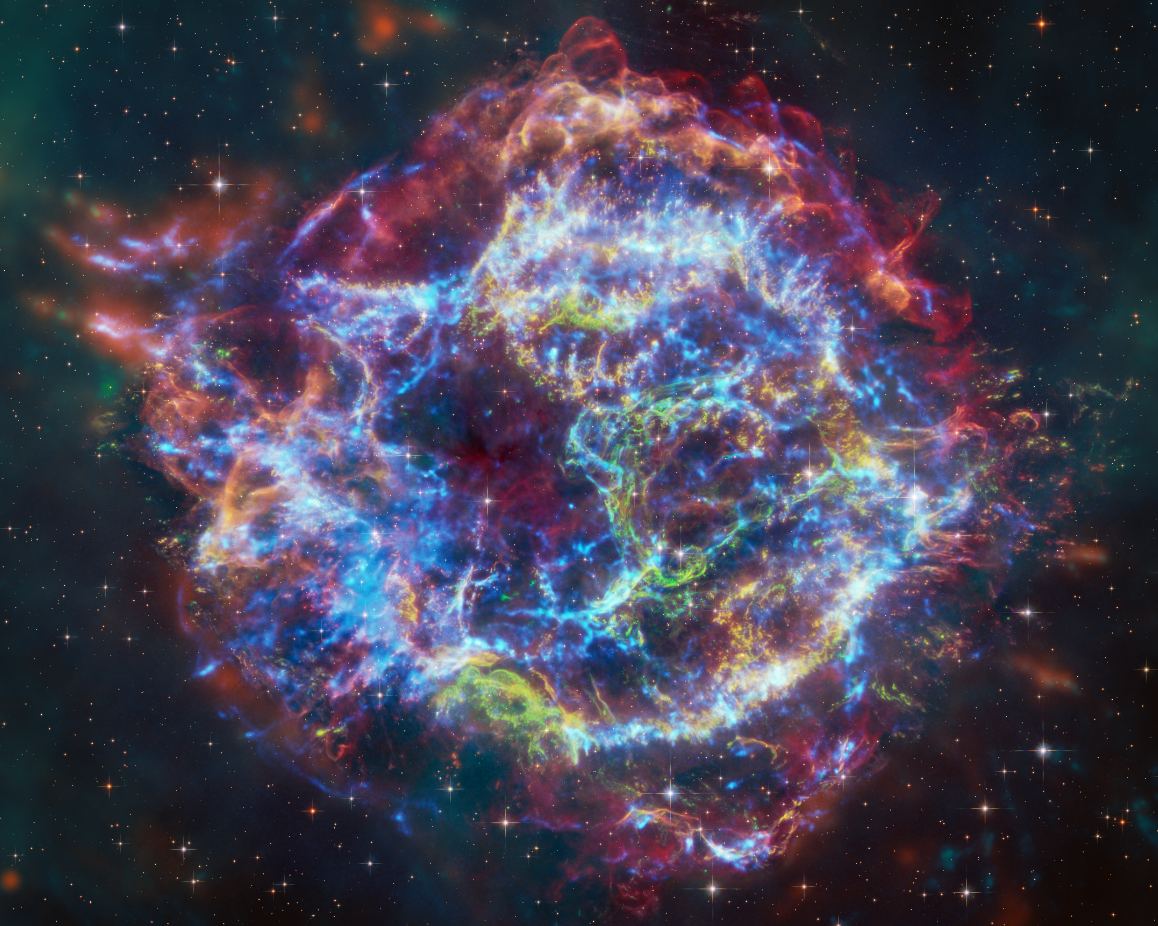NASA’s long-lived Chandra X-ray Observatory teamed up with JWST for the first time, producing this incredibly detailed image of the famous supernova remnant Cassiopeia A. JWST first looked at the remnant in April 2023, and noticed an unusual debris structure from the destroyed star, dubbed the “Green Monster.” The combined view has helped astronomers better understand what this unusual structure is, plus it uncovered new details about the explosion that created Cas A.
This new image also includes data from the venerable Hubble Space Telescope and the Spitzer Space Telescope. The supernova explosion that created the iconic remnant only took place about 340 years ago. The new images and details were presented by Dan Milisavljevic from Purdue University at the 243rd meeting of the American Astronomical Society in New Orleans.
This colorful view can be divided into the various colors, which represents different wavelengths of light that were seen by the different telescopes. The X-rays seen by Chandra are blue, and this data revealed the hot gas in the debris is made of elements like silicon and iron. Astronomers believe the X-rays come from supernova debris from the destroyed star, which produced energetic electrons moving through the magnetic field lines in the blast wave. X-rays are also present as thin arcs in the outer regions of the remnant.

The infrared data from JWST are red, green, blue, which shows infrared emissions from dust that is warmed up because it is embedded in the hot gas. The optical data from Hubble are seen as red and white, which shows the stars in the field. The outer parts of the image also include infrared data from NASA’s Spitzer Space Telescope, seen in red, green and blue.
The astronomers who analyzed this data found that the filaments in the outer part of Cas A, from the blast wave, closely matched the X-ray properties of the Green Monster, including less iron and silicon than in the supernova debris.
You can see in this image below, which shows that the colors inside the Green Monster’s outline matches with the colors of the blast wave rather than the debris with iron and silicon. The researchers concluded that the Green Monster was created by a blast wave from the exploded star slamming into material surrounding it, supporting earlier suggestions from the JWST’s data alone.
“We already suspected the Green Monster was created by a blast wave from the exploded star slamming into material surrounding it,” said Jacco Vink of the University of Amsterdam, who lead the Chandra work. “Chandra helped us clinch the case.”

The debris from the explosion can be seen by Chandra because it is heated to tens of millions of degrees by shock waves. JWST’s data shows some material that has not been affected by shock waves, what can be called “pristine” debris.
In attempt to learn more about the supernova explosion, the researchers compared the JWST view of the pristine debris with X-ray maps of radioactive elements that were created in the supernova. They used NASA’s Nuclear Spectroscopic Telescope Array (NuSTAR) data to map radioactive titanium, and Chandra to map where radioactive nickel was by measuring the locations of iron. Radioactive nickel decays to form iron. An additional image shows the iron-rich debris (tracing where radioactive nickel was located) in green, the radioactive titanium in blue and the pristine debris seen in orange and yellow.
They said their analysis suggests that radioactive material seen in X-rays has helped shape the pristine debris near the center of the remnant seen with Webb, forming cavities. The fine structures in the pristine debris were most likely formed when the star’s inner layers were violently mixed with hot, radioactive matter produced during collapse of the star’s core under gravity.
“We’ve made the first map of the web-shaped, pristine debris in the center of this supernova remnant,” said Milisavljevic. “No one has ever seen structures like this before in an exploded star.”
You can see more images and details of Cas A at the Chandra website.

